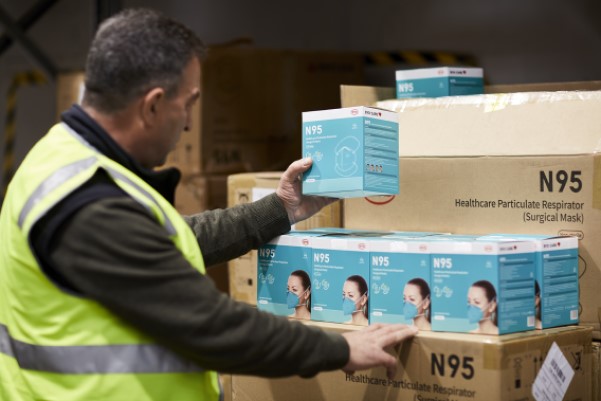19 November 2021
1.5 million masks a week for Victorian public hospitals

Victorian health care workers are using more than 1.5 million respirator masks every week.
In total, HSV has purchased over 366 million surgical and respirator masks since the start of the COVID-19 pandemic.
Judy Esson, HSV’s Clinical Product Manager (CPM), explains how she works with Clinical Product Advisors (CPAs) across the sector to ensure a reliable supply of PPE to protect Victoria’s health care workers.
How many masks has HSV assessed since the pandemic began?
Over 50 different surgical masks and N95 (P2) respirators, including all the necessary documentation and samples.
What’s the difference between surgical masks and respirators?
Surgical masks resist fluid splash at levels of 80mm Hg (Level 1), 120mm Hg (Level 2) or 160mm Hg (Level 3).
Respirators filter particles and are used in all types of industries. Additionally, they can also be made to resist fluid splash in health care settings – we call these surgical respirators. N95 is the USA standard and P2 is the Australian standard.
How many different types of masks are available?
There are now twelve types of N95 respirator masks available for health services to fit test and then order, in small and medium sizes and a variety of styles.
For surgical masks the number is much less, the variety is dependent on supply. Currently, there are three brands of Level 2 masks with ear loops and two types of Level 3 masks with ties.
How is PPE being distributed?
Early in the pandemic the Victorian Government centralised Tier 1 PPE stock into the State Supply Chain. HSV works to secure the stock and Monash Health fulfils the orders from public health services. It has been a very successful initiative and has helped manage spikes in demand.
How does HSV assess masks?
We check the quality of the product samples and try them on. We check Australian Register of Therapeutic Goods (ARTG) registration and review test reports. HSV Procurement team members will conduct a probity check on suppliers we are unfamiliar with.
We also work closely with Clinical Product Advisors (CPAs) and Clinical Product Managers (CPMs) across the health sector, who often test products and provide valuable feedback.
What is fit testing?
Faces come in all shapes and sizes and fit testing helps a health care worker find out which mask gives them the best protection.
Fit testing was introduced in Victorian hospitals in winter 2020 and over 100,000 health care workers have now been fit tested. The learning curve has been steep.
HSV’s Equipment team very quickly set up a contract for the fit testing equipment and service providers. It is now an annual requirement and a very important safety initiative.
Does fit testing drive what health services order?
Yes, it often does. Ideally, we ask for health care workers to be fitted to three styles to reduce a health service’s dependence on one, in the event of a shortage. However, some health care workers only fit one specific brand and code.
Suppliers have responded to feedback and provided additional information about how to properly ‘don’ (put on) and ‘doff’ (take off) respirator masks and other PPE.
Does the fit testing program influence what HSV procures?
Yes, absolutely. Fit testing results help HSV forecast future demand for certain masks, in tandem with the ‘burn rate’, which is the volume used each week.
What happens when health services give us negative feedback about masks we have procured?
Feedback from CPAs and CPMs in health services is very important and we thoroughly investigate issues raised. Detailed information really helps, such as the brand, code, batch/lot number, the number of faults, how, when and where the fault occurred and an all-important photo.
We record all incidents and check if there are trends in reporting and HSV Category Managers and our HSV clinical advisors will often discuss issues with suppliers.
We continue further investigation as required, report to the State Supply Chain (SSC) Steering Committee and this is where a decision is made about any action required. An investigation can take several weeks to months and we advise health services of any action or resolution.
Further information
HSV’s Product Information Library is a single source of information about efficacy and safety on Tier 1 PPE, including every mask available in the state supply. Visible only to health services, the library is accessible via a quick link located within the My Dashboard area after logging in via the HSV website.